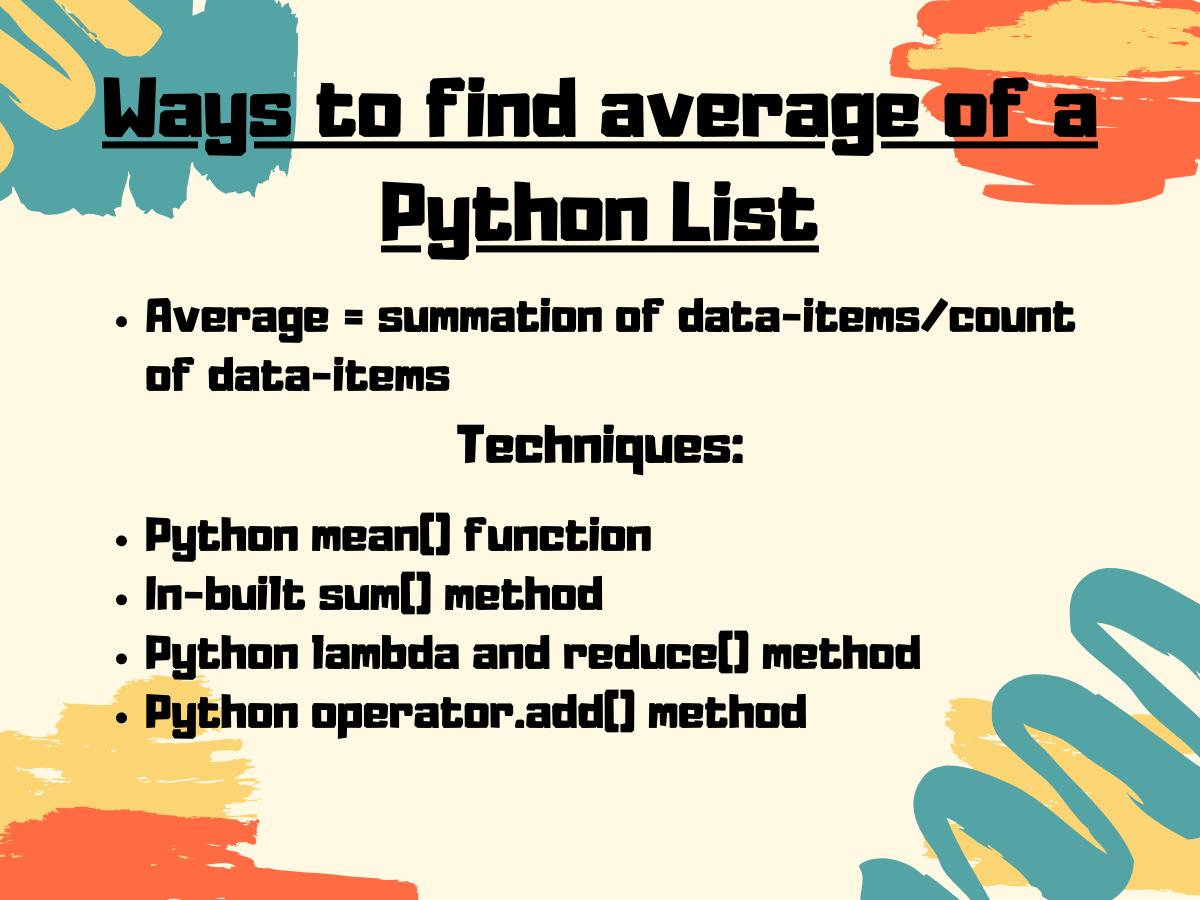- Log in to:
- Community
- DigitalOcean
- Sign up for:
- Community
- DigitalOcean
By Safa Mulani

Hi Folks! In this article, we will have a look at the various ways to find the average of a list in a Python List.
In general, an average is a value that represents a whole set of data items or elements.
Formula: Average = summation of numbers/total count.
Techniques to find the average of a list in Python
Either of the following techniques can be used to calculate the average/mean of a list in Python:
- Python mean() function
- In-built sum() method
- Python lambda and reduce() method
- Python operator.add() method
1. Python mean() function
Python 3 has statistics module which contains an in-built function to calculate the mean or average of numbers. The statistics.mean() function is used to calculate the mean/average of input values or data set.
The mean() function accepts the list, tuple or data-set containing numeric values as a parameter and returns the average of the data-items.
Syntax:
mean(data-set/input-values)
Example:
from statistics import mean
inp_lst = [12, 45, 78, 36, 45, 237.11, -1, 88]
list_avg = mean(inp_lst)
print("Average value of the list:\n")
print(list_avg)
print("Average value of the list with precision upto 3 decimal value:\n")
print(round(list_avg,3))
In the above snippet of code, we have used statistics.round() method to round off the output average up to a particular decimal value.
Syntax:
statistics.round(value, precision value)
Output:
Average value of the list:
67.51375
Average value of the list with precision upto 3 decimal value:
67.514
2. Using Python sum() function
Python statistics.sum()function can also be used to find the average of data values in Python list.
The statistics.len() function is used to calculate the length of the list i.e. the count of data items present in the list.
Syntax:
len(input-list)
Further, statistics.sum() function is used to calculate the sum of all the data items in the list.
Syntax:
sum(input-list)
Note: average = (sum)/(count).
Example:
from statistics import mean
inp_lst = [12, 45, 78, 36, 45, 237.11, -1, 88]
sum_lst = sum(inp_lst)
lst_avg = sum_lst/len(inp_lst)
print("Average value of the list:\n")
print(lst_avg)
print("Average value of the list with precision upto 3 decimal value:\n")
print(round(lst_avg,3))
Output:
Average value of the list:
67.51375
Average value of the list with precision upto 3 decimal value:
67.514
3. Using Python reduce() and lambda method
We can use Python reduce() function along with the lambda() function.
Python reduce() function: The reduce() function is basically used to apply a particular(input) function to the set of elements passed to the function.
Syntax:
reduce(function,input-list/sequence)
- Initially, the reduce() function applies the passed function to the first two consecutive elements and returns the result.
- Further, we apply the same function to the result obtained in the previous step and the element succeeding the second element.
- This process continues until it reaches the end of the list.
- Finally, the result is returned to the terminal/screen as output.
Python lambda() function: The lambda() function is used to build and form Anonymous functions i.e. function without a name or signature.
Syntax:
lambda arguments:function
Example:
from functools import reduce
inp_lst = [12, 45, 78, 36, 45, 237.11, -1, 88]
lst_len= len(inp_lst)
lst_avg = reduce(lambda x, y: x + y, inp_lst) /lst_len
print("Average value of the list:\n")
print(lst_avg)
print("Average value of the list with precision upto 3 decimal value:\n")
print(round(lst_avg,3))
Output:
Average value of the list:
67.51375
Average value of the list with precision upto 3 decimal value:
67.514
4. Python operator.add() function to find the average of a list
The Python operator module contains various functions to perform basic calculations and operations efficiently.
The operator.add() function can be used to calculate the summation of all the data values present in the list with the help of Python reduce() function.
Syntax:
operator.add(value1, value2)
Note: average = (sum)/(length or count of elements)
Example:
from functools import reduce
import operator
inp_lst = [12, 45, 78, 36, 45, 237.11, -1, 88]
lst_len = len(inp_lst)
lst_avg = reduce(operator.add, inp_lst) /lst_len
print("Average value of the list:\n")
print(lst_avg)
print("Average value of the list with precision upto 3 decimal value:\n")
print(round(lst_avg,3))
Output:
Average value of the list:
67.51375
Average value of the list with precision upto 3 decimal value:
67.514
5. NumPy average() method to calculate the average of a list in Python
Python’s NumPy module has an in-built function to calculate the average/mean of the data items present in the data set or list.
The numpy.average() method is used to calculate the average of the input list.
Example:
import numpy
inp_lst = [12, 45, 78, 36, 45, 237.11, -1, 88]
lst_avg = numpy.average(inp_lst)
print("Average value of the list:\n")
print(lst_avg)
print("Average value of the list with precision upto 3 decimal value:\n")
print(round(lst_avg,3))
Output:
Average value of the list:
67.51375
Average value of the list with precision upto 3 decimal value:
67.514
Conclusion
Thus, in this article, we have unveiled and understood various techniques to find the average of a Python List.
Thanks for learning with the DigitalOcean Community. Check out our offerings for compute, storage, networking, and managed databases.
Still looking for an answer?
Deploy on DigitalOcean
Click below to sign up for DigitalOcean's virtual machines, Databases, and AIML products.
Become a contributor for community
Get paid to write technical tutorials and select a tech-focused charity to receive a matching donation.
DigitalOcean Documentation
Full documentation for every DigitalOcean product.
Resources for startups and SMBs
The Wave has everything you need to know about building a business, from raising funding to marketing your product.
Get our newsletter
Stay up to date by signing up for DigitalOcean’s Infrastructure as a Newsletter.
New accounts only. By submitting your email you agree to our Privacy Policy
The developer cloud
Scale up as you grow — whether you're running one virtual machine or ten thousand.
Get started for free
Sign up and get $200 in credit for your first 60 days with DigitalOcean.*
*This promotional offer applies to new accounts only.
